Looking for a solid cardio workout without pounding your joints? A cross trainer (aka elliptical trainer) is a smart choice. It’s low-impact, easy on the knees, and still gets your heart rate up, great for beginners or anyone adding variety to their routine.
The best cross trainers give you a full-body workout, hitting your legs, core, and upper body in one smooth motion. They’re especially good for building endurance, boosting cardio fitness, and burning calories without the wear and tear of running.
That said, the market is packed with options. Whether you’re just starting out or want to level up your home gym, picking the right cross trainer can feel overwhelming. That’s where this guide comes in, we’ll help you cut through the noise and find the one that fits your needs and budget.
What to Look for in a Home Cross Trainer
Not all cross trainers are equal. Some are perfect for beginners, others for professional athletes. Here's what we recommend you look for when buying:
✅ Stride Length
A longer stride (around 46-51 cm) is better if you're taller. Shorter stride lengths are fine for smaller machines or short operators but will be jerky in the long haul.
✅ Flywheel Weight & Resistance
Higher levels of resistance provide more control during your exercise. Heavier flywheels (above 12-14kg) will be smoother and more stable, especially when pedaling quickly.
✅ Space and Storage
Be aware of the floor space available to you. Front-wheel drive machines will take up less room than rear-wheel drive machines. Transport wheels or folding machines are found on some cross-trainers for easy portability and storage.
✅ Smart Features
Guided exercise or monitoring of progress? Look for Bluetooth connectivity, app compatibility (i.e., iFIT or Kinomap), or built-in screens with training programs.
✅ Noise Level
If you're in an apartment or share a room, go for a machine with magnetic resistance, they are quiet and silky smooth. Less expensive machines with fan or friction resistance can be noisy.
✅ Build Quality
Look for sturdy frames, high user weight limits (100kg+), and solid guarantees. Thin machines with weak construction never survive more than a few months under regular use.
How We Tested These Cross Trainers
We don’t guess, we test.
Every machine on this list was assembled, adjusted, and used by our in-house personnel here at Home Gym Supply. Some of us are personal trainers. Some just like a good workout. All of us care about how a machine performs on a daily basis.
Here’s what we looked at:
- Stability - How does it handle high intensity workouts?
- User comfort - How does the stride feel? Are the grips natural?
- Noise - Can this be used early without waking the family or flatmates?
- Durability - Does it look like it will last day to day?
- Features - Is the console easy to use? Do programs really help?
We also considered feedback from customers who've had these models for months or years - not just the fresh-out-of-the-box initial impression.
1. Best Elliptical Overall: NordicTrack AirGlide 14i
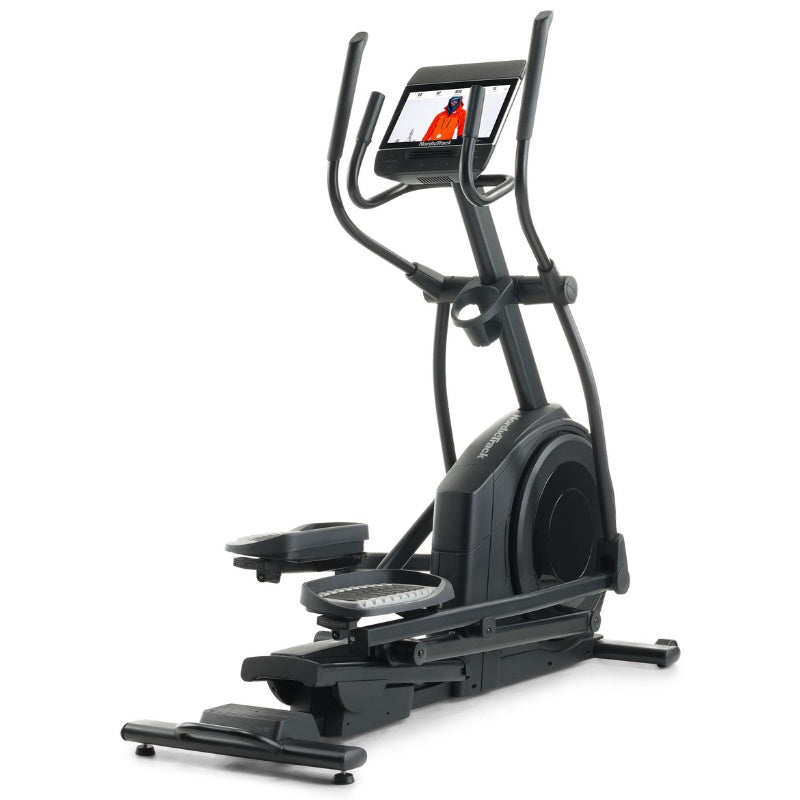
| Flywheel Weight |
15kg |
| Adjustable Resistance Levels |
26 |
| Assembled Dimensions |
175cm (L) x 63cm (W) x 180cm (H) |
| Maximum User Weight |
135kg |
Best for: People who want premium features and incline training in one machine
The NordicTrack AirGlide 14i is the kind of elliptical that makes you take notice, not just because of its sleek design, but because it performs like a high-end machine. During testing, it felt solid and well-built, with a smooth, quiet stride that held up even during longer, more intense workouts.
The big draw here is the 36 cm (14-inch) Smart HD touchscreen, which integrates seamlessly with iFIT. That means access to 16,000+ on-demand workouts, scenic routes, studio classes, and trainers who can auto-adjust your incline and resistance mid-session. It's not just a gimmick, the automation keeps your workouts challenging and varied without you having to touch a button.

What sets the AirGlide apart is the incline and decline range: from -5% to 15%, which lets you target different muscle groups, something you don’t see on many ellipticals. Add in the auto-adjusting stride and you’ve got a machine that works well for users of different heights.
The 15 kg flywheel gives it a solid, stable feel, and with 26 resistance levels powered by Silent Magnetic Resistance, transitions are smooth and the noise is minimal. Max user weight is 135 kg, and the build feels like it can handle that without any issues.
You will need an iFIT membership to get the most out of it, and yes, it’s a big upfront investment. But for people serious about interactive training and incline options, this machine delivers.
What our tester says:
“I like that the machine adjusts automatically with the trainer, it makes the whole workout feel more immersive, and you can just focus on pushing yourself.”
Specs
- Footprint: 175 cm L x 63 cm W x 180 cm H
- Machine Weight: 111 kg (boxed)
- Weight Capacity: 135 kg
- Flywheel: 15 kg
- Resistance: 26 levels (Silent Magnetic Resistance)
- Incline/Decline: -5% to 15%
- Monitor: 36 cm (14-inch) Smart HD Touchscreen
- Warranty: 10-year frame, 2-year parts, 1-year labor
-
Metrics Tracked: Calories, time, heart rate, distance, pace, speed, resistance, incline
2. Best Budget Cross Trainer: Dripex Magnetic Cross Trainer

| Flywheel Weight |
6kg |
| Adjustable Resistance Levels |
8 |
| Assembled Dimensions |
99cm (L) x 49cm (W) x 150cm (H) |
| Maximum User Weight |
120kg |
Best for: People who want a quiet, compact elliptical without breaking the bank
If you're looking for an elliptical under £200, the Dripex Magnetic Cross Trainer is one of the better options out there. It’s compact, quiet, and does the basics well, ideal for beginners or casual users working out at home.
The 6kg rear-drive flywheel won’t blow you away with intensity, but it delivers a smooth enough stride for steady cardio. With 8 levels of magnetic resistance, there’s enough challenge for light to moderate workouts. If you’re training hard or want high-resistance intervals, this won’t be the machine for you.
You’ll get a basic LCD monitor to track your stats and a tablet holder, which makes it easier to get through longer sessions. The compact footprint and transport wheels make it a good fit for small spaces. Just note: the 35cm stride is short, especially for taller users it might feel more like a stepper than a full elliptical stride.
What our tester says:
“It’s super quiet (big plus for home workouts) and the tablet holder is a nice touch. For the price, it’s a great entry-level pick.”
Specs
- Flywheel: 6kg rear drive
- Resistance Levels: 8 magnetic
- Dimensions: 99 cm (L) x 49 cm (W) x 150 cm (H)
- Max User Weight: 120 kg
- Stride Length: 35 cm (adjustable)
- Display: LCD
3. Best Smart Budget Elliptical: ProForm 420E
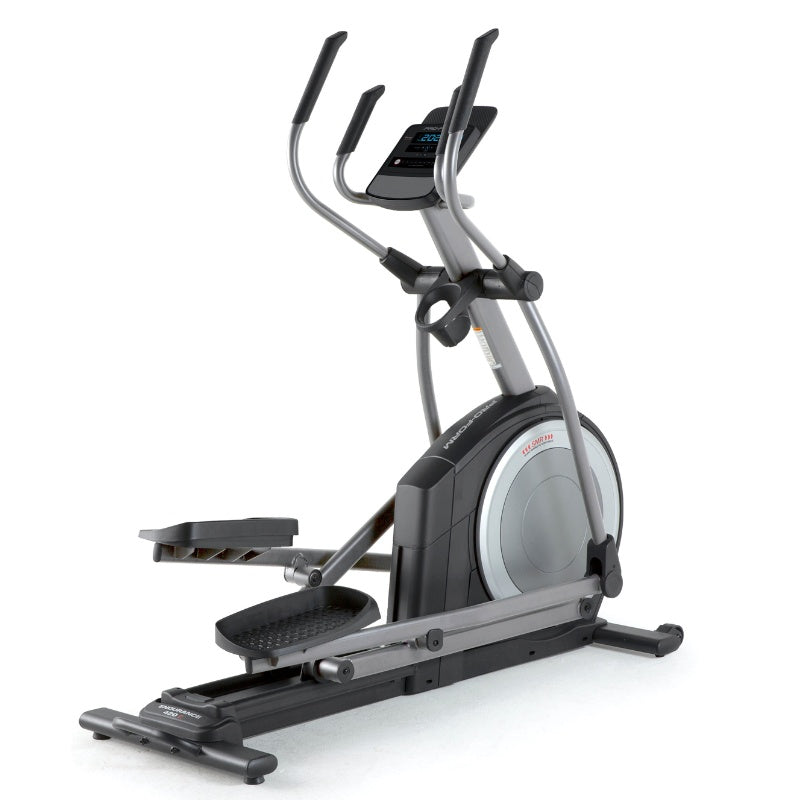
| Flywheel Weight |
7kg |
| Adjustable Resistance Levels |
16 |
| Assembled Dimensions |
173cm (L) x 84cm (W) x 170cm (H) |
| Maximum User Weight |
125kg |
Best for: Budget shoppers who still want smart features and a quiet ride
The ProForm 420E is a solid pick if you're on a budget but still want some tech in the mix. It’s not flashy, but it checks a lot of boxes for the price. During testing, the ride felt smooth and quiet, thanks to a 7kg flywheel paired with Silent Magnetic Resistance (SMR™). It handled steady-state workouts and light intervals well.
You get 16 digital resistance levels, which is enough to keep things challenging for most users. The 13 cm (5-inch) LCD display is simple and easy to read, showing all the usual metrics. One of the smarter design choices: the tablet holder sits above the display, so you can stream workouts or shows while still keeping an eye on your stats. It’s also Bluetooth-enabled, making it compatible with iFIT if you want guided training.
Build-wise, it felt stable during use and supports users up to 125kg. It’s not a compact machine, but the footprint is reasonable for a front-drive elliptical.
What our tester says:
“The tablet holder placement is spot-on — I could stream workouts and still see my stats without having to shift my view.”
Specs
- Flywheel: 7kg effective inertia
- Resistance Levels: 16 digital
- Dimensions: 173 cm (L) x 84 cm (W) x 170 cm (H)
- Max User Weight: 125 kg
- Stride Length: 46 cm (18-inch)
- Display: 13 cm (5-inch) high-contrast multi-color LCD
4. Best Entry-Level Elliptical: Reebok ZR8
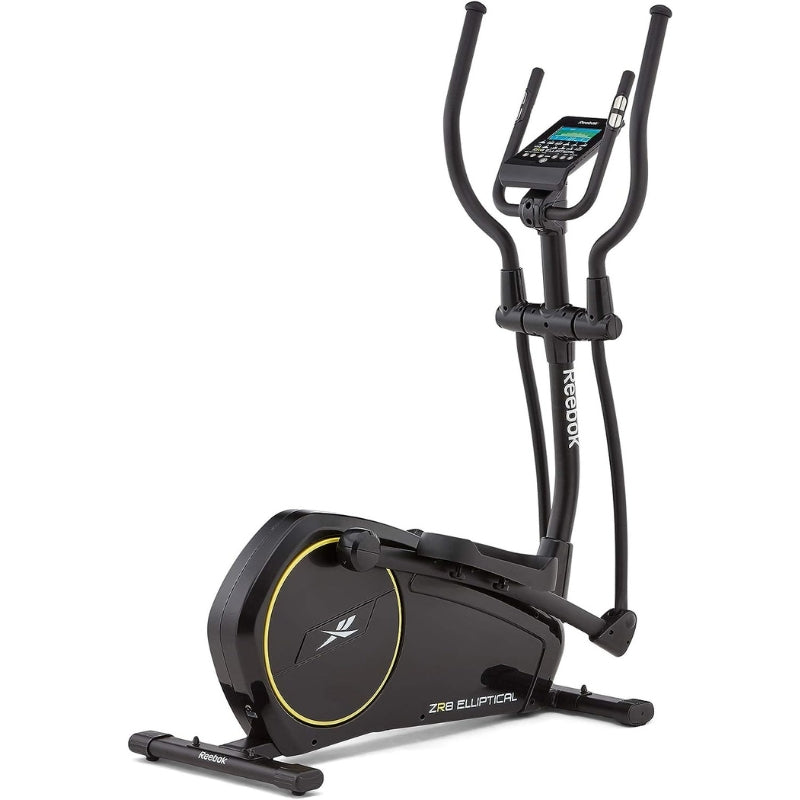
| Flywheel Weight |
9kg |
| Adjustable Resistance Levels |
32 |
| Assembled Dimensions |
144cm (L) x 63cm (W) x 169cm (H) |
| Maximum User Weight |
120kg |
Best for: Beginners or budget buyers who want a smooth, stable ride without extra fluff
The Reebok ZR8 might come in at an entry-level price, but it doesn’t feel cheap. During testing, it impressed us with its solid build quality and quiet performance — two things you don’t always get in this price range.
With a 9kg rear-drive flywheel and 32 electronic resistance levels, it delivered a smooth stride and enough resistance range to challenge most beginners. Resistance changes felt fluid, making it easy to stay in the zone without distractions.
The 14.5 cm (5.75-inch) LCD display gives you the basics — speed, time, distance, calories — and the integrated tablet holder means you can stream your own workouts or entertainment while still seeing your stats. It stayed stable even during tougher pushes, and the transport wheels make it easy to move when you're done.
It supports users up to 120kg, which is solid for the price point. Overall, it’s a reliable, no-frills option that feels better than you'd expect for the cost.
What our tester says:
“This felt much sturdier than I expected for the price, and the smooth resistance transitions meant I could focus on the workout.”
Specs
- Flywheel: 9kg rear drive
- Resistance Levels: 32 electronic
- Dimensions: 144 cm (L) x 63 cm (W) x 169 cm (H)
- Max User Weight: 120 kg
- Monitor: 14.5 cm (5.75-inch) LCD
5. Best for Natural Stride Feel: DKN XC-190
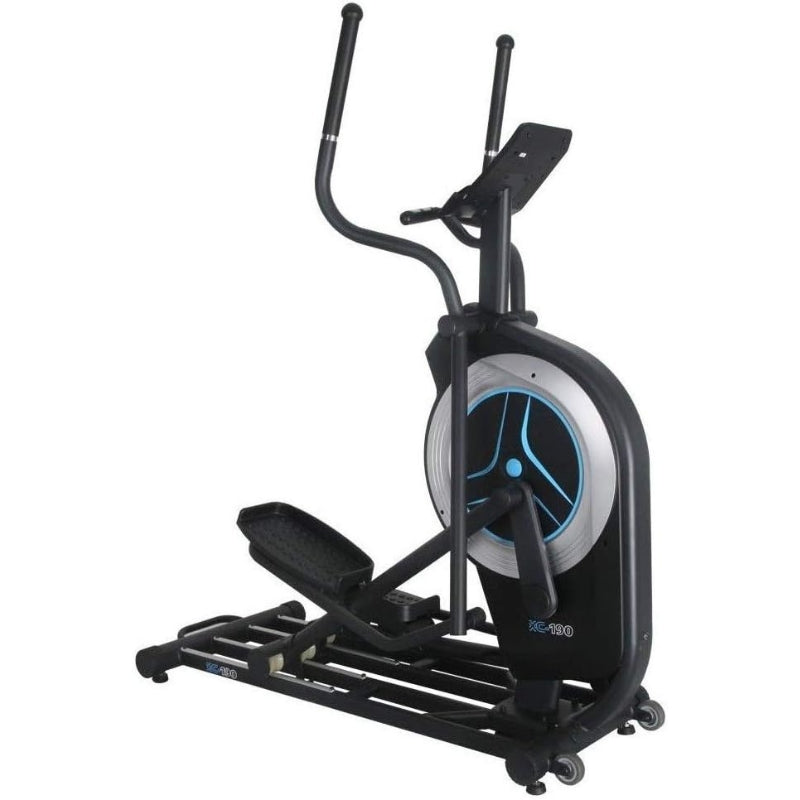
| Flywheel Weight |
10kg |
| Adjustable Resistance Levels |
32 |
| Assembled Dimensions |
153cm (L) x 55cm (W) x 173cm (H) |
| Maximum User Weight |
130kg |
Best for: Users who want a quiet, smooth elliptical with a natural feel and solid build
The DKN XC-190 stood out during testing for its sturdy frame and smooth, stable performance. Despite its compact size, it felt like a high-quality machine built to last. The 10kg rear-drive flywheel delivered a quiet, consistent motion that stayed smooth even during tougher intervals.
What really set this elliptical apart was the low 5cm Q-factor — the distance between the pedals. That narrow stance made the stride feel more natural and comfortable, especially on longer sessions. It’s a feature you don’t always see on machines at this price point.
With 32 levels of electronic resistance, there’s enough range to challenge a variety of fitness levels. The blue backlit LCD console is basic but easy to read. You won’t get a flashy touchscreen here, but it covers the essentials, and Bluetooth connectivity gives you access to compatible training apps for added variety.
Max user weight is 130kg, and the 53 cm (21-inch) stride length suits most users well. If you’re after a quiet, no-nonsense elliptical that feels great to use, this one checks a lot of boxes.
What our tester says:
“The low Q-factor really made a difference; it felt much more natural and comfortable on my hips than other machines.”
Specs
- Flywheel: 10kg rear drive
- Resistance Levels: 32 electronic
- Stride Length: 53 cm
- Max User Weight: 130 kg
- Console: Blue backlit LCD
- Warranty: 2 years parts and labour
6. Best App-Connected Budget Elliptical: Viavito Sina
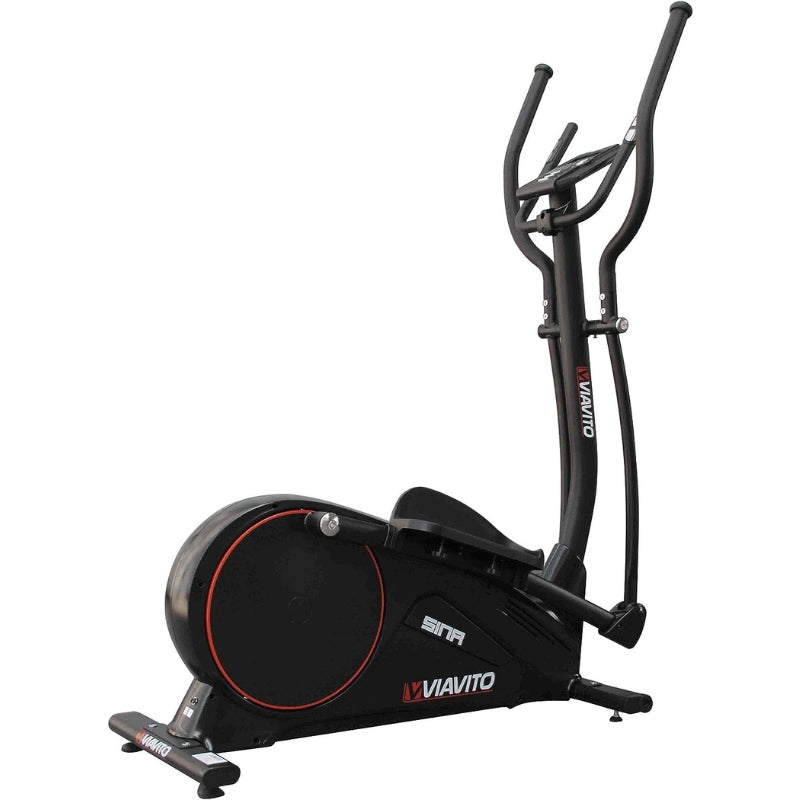
| Flywheel Weight |
9kg |
| Adjustable Resistance Levels |
32 |
| Assembled Dimensions |
132cm (L) x 55cm (W) x 170cm (H) |
| Maximum User Weight |
120kg |
Best for: Users who want a smooth, quiet ride with app connectivity, without spending big
The Viavito Sina punches above its weight for a budget elliptical. During testing, we were impressed by how smooth and quiet it ran, thanks to a 9kg flywheel that delivers a steady, fluid stride.
You get 32 electronic resistance levels, offering plenty of challenge whether you're doing steady-state cardio or intervals. The dual-color LCD console is basic but does the job — clear and easy to read. A smart touch: the tablet holder is well-positioned, and the Bluetooth connectivity lets you hook up to apps like Kinomap for interactive workouts, which helps keep things fresh.
The 38cm stride length felt comfortable for most users, and the frame stayed stable during sessions. For the price, this is a well-rounded elliptical that brings solid performance and a few smart features without pushing into premium territory.
What our tester says:
“For an elliptical at this price, the smooth motion was impressive, and being able to use Kinomap with the tablet holder is a big plus.”
Specs
- Flywheel: 9kg
- Resistance Levels: 32 electronic
- Stride Length: 38 cm
- Dimensions: 132 cm (L) x 55 cm (W) x 170 cm (H)
- Max User Weight: 120 kg
- Monitor: Dual-color backlit LCD
Cross Trainer Buyer's Guide - Find the Right one for you
What’s a Cross Trainer?
For those who don't know, a cross trainer is a special type of cardio machine that has a running-like motion but also uses your arms. It works both your upper and lower body simultaneously.

The Benefits of Cross Trainers
Before you start thinking about buying a cross trainer, you need to evaluate whether or not its benefits are right for you, so let's take a quick look at what benefits cross trainers bring to the table.
Firstly, they provide an excellent cardiovascular workout which will help with cardiovascular fitness helping improve heart and lung strength and more.
By providing you with a solid cardiovascular workout, you also burn calories, and that means shedding pounds. It's all about boosting that metabolism.
One of the most beneficial aspects of a cross trainer is the fact that it is a form of low-impact exercise that does not negatively impact your knees or hips due to impacts, such as running which can cause injury over time.
Another benefit of using a cross trainer is that it's ideal for people who don't have great balance because your feet never actually leave the pedals.
If you want to take a deeper look at the benefits, see our post on cross trainer benefits.
Types of Cross Trainers to Consider
Before we get to the actual buying guide, you need to know that there are several different types of cross trainers, each one with specific features and benefits.

Manual or Magnetic Resistance
First and foremost, you can choose between manual and electric cross trainers. A manual cross trainer is powered by nothing else but your movement, so there aren't any buttons. There is however a manual resistance dial.
Magnetic cross trainers on the other hand have displays that allow you to use buttons to change the resistance levels and are typically very quiet when buying used and require less maintenance of the cross trainer.
Front vs Rear Drive
What you also need to consider is the difference between a front-drive and a rear drive cross trainer which refers to where they flywheel is mounted on the machine.
A cross trainer that features a front-drive setup has the flywheel positioned at the front of the machine in front of the pedals. This helps to keep their footprint to a minimum which is great if you are short on space.
On the other hand, we have rear drive cross trainers, which feature the flywheel position behind the pedals. They are typically bulkier and pricier than front drive cross trainers. But they generally allow you to adjust the stride length which could be a better choice if you are quite tall.

Two-in-One Cross Trainer and Exercise Bikes
If you're looking to get the most out of your money, then you can always go for a two-in-one cross trainer that combines both a cross trainer and an exercise bike. However, these models tend to be low quality and the cycling experience isn't quite as enjoyable as the pedals are the wrong shape.
Factors to Consider When Buying a Cross Trainer
When choosing a cross trainer, there are many different factors that you need to consider, and right now, we want to cover all of them, starting with what your overall purpose is.
Your Needs and Purpose
First and foremost, when you are choosing a cross trainer, you need to decide what goals you have.
For instance, if you're looking to improve your cardiovascular fitness or lose weight, then you should choose a cross trainer that has many different features that relate to cardiovascular health, such as preset cardio programs and advanced calorie tracking capabilities.
However, if what you're looking for more than anything is to build strength and tone your muscles, then incline capabilities and a heavier flywheel to provide more resistance are features worth looking for.
For instance, if you have high resistance settings, you can easily mimic uphill jogging or walking, therefore toning your muscles.
Whatever the case may be, cross trainers are excellent choices for those who have joint concerns and for those recovering from an injury, as this is a low impact form of exercise.

Spatial Requirements
The next thing that you need to consider when choosing a cross trainer is how much space you have to spare.
For instance, most cross trainers are generally anywhere from 1.2 to 2.5 meters in length, but that's not the only thing you need to consider.
Consider that to use the machine safely, you'll also need additional space on either side of the machine, as well as behind it.
Moreover, make sure that the unit in question is not so tall that you need to worry about overhead clearance because if you have low ceilings, this can be a problem.
If you have a small space, consider getting a cross trainer with a foldable design or a compact frame, so you don't take up too much space.
On that note, you'll also want to take into account the weight of the machine, as the heavier the machine is, the more stable it will be.
Stride Length
If you are tall or short, the stride length is also worth checking as this directly affects how comfortable and natural the motion feels while working out.
For those who don't know, your stride length is the maximum distance between the front foot and back foot when you are pedalling.
There are those machines with a shorter stride length, up to around 41 cm (16 inches), which are suitable for those with shorter legs and for regular walking.
However, if you're taller or just want to go faster, then you want to look for a cross trainer that has a stride length of up to 56 cm (22 inches). This will allow for a more natural and fluid range of motion, especially if you want to engage in a high-intensity workout.

Resistance
Resistance is always one of the most important factors when choosing a cross trainer. Generally speaking, whether you have a manual or magnetic resistance cross trainer, the heavier the flywheel the more resistance it can produce.
You also want to check the levels of resistance the cross trainer in question has as this will make it possible to progress over time and find the right level for you.
Incline
Incline is another option that some of the higher end models have available.
If you're going for muscle strength and toning, then a higher end model that features incline settings is certainly worth it.
By adjusting the incline, you can simulate uphill movements, therefore increasing engagement of your core, hamstring, calves and glute muscles.
The Flywheel
Another important factor you need to consider when choosing a cross trainer best for you is the flywheel. The flywheel determines how smooth and consistent the pedaling motion is.
As we saw with the resistance, heavier flywheel will create a more smooth experience, because the added weight of the flywheel generates a lot more momentum.
For most people, a flywheel weight of between 7 kg and 9 kg (15-20 lbs) should be enough for a smooth workout.
However, more advanced higher end models may feature flywheels with weights exceeding 11 kg (25 lbs), allowing for an even more stable experience, which is essential for long duration or high intensity exercise sessions.

The Console and Connectivity
The console or display on the cross trainer in question is also very important to consider. It can have a significant impact on your overall workout experience.
At the very least, you should have a basic console that is able to display metrics such as calories burned, heart rate, distance, time, and speed so you can track your progress.
However, if you're going for something higher end, you'll get touch screen displays that feature built-in workout programs, and often even interactive training sessions.
There are also many cross trainers which feature displays that are compatible with various fitness apps, allowing you to synchronize your workout data and get access to virtual training sessions.
These virtual workouts can help make your workouts more challenging and enjoyable, which in turn could help you stay consistent.
There are also plenty of consoles that are both Wi-Fi and Bluetooth enabled, providing you with even more benefits. You may also want to pay attention to cross trainers that are compatible with wearable fitness devices.

Materials, Build Quality, and Stability
Perhaps one of the most important considerations to keep in mind when choosing a cross trainer is what it is built out of.
Generally speaking, you want a model that is built out of a high-quality material such as steel, or at the very least, high-quality aluminum.
The bottom line here is that metal is always best, and the less plastic there is on a cross trainer, the better. On that note, you do want a cross trainer that has a high maximum weight capacity, as this indicates a high-quality build.
Not only does it indicate a high-quality build, but you also need to pay attention to the weight capacity in relation to your own weight.
You generally want to look for a cross trainer that has a weight capacity of at least 130 kilograms (around 290 lbs), as this will allow for greater stability.
Related Post: Cross Trainer Vs Treadmill: Which is Better?
Noise Level
Something else that you want to consider when choosing a cross trainer is how loud it is. Manual cross trainers can be a little noisie although magnetic cross trainers tend to be almost silent.
Price, Value, and Warranty
Finally, you then want to consider the price of the unit in question. After all, you're probably working on a budget, but you do need to keep in mind that the overall value of the cross trainer will be relative to its price.
You may be tempted to go for the very cheapest model, but remember that durability and quality generally come with a higher price tag.
You always want to look at user reviews, build quality, and the cross trainers features to determine if it is a good value for the price it costs.
On that note, you also want to look for a model that comes complete with a good warranty with a trusted brand for added peace of mind. Always look for warranties that cover home repairs, labour, and parts, for at least one year, preferably two.
Rounding Up
At the end of the day, as long as you keep all of these essential factors in mind, you should have no problems choosing a cross trainer that is best for your needs.
Keep in mind the build quality, stability, the console, connectivity, and overall comfort levels, and you'll be able to find a cross trainer that lets you burn calories, shed pounds, and build some muscle all at the same time.
Lastly, for extra variety, see our cross trainer workouts which help keep you motivated.

